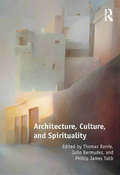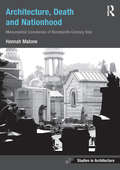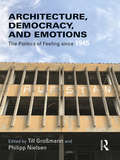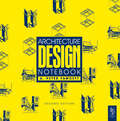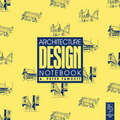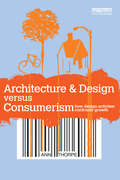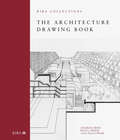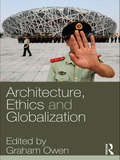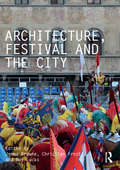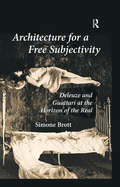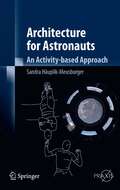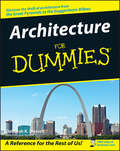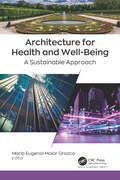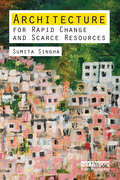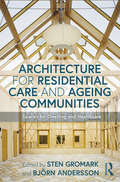- Table View
- List View
Architecture, Culture, and Spirituality
by Thomas Barrie Julio BermudezArchitecture has long been understood as a cultural discipline able to articulate the human condition and lift the human spirit, yet the spirituality of architecture is rarely directly addressed in academic scholarship. The seventeen chapters provide a diverse range of perspectives, grouped according to topical themes: Being in the World; Sacred, Secular, and the Contemporary Condition; Symbolic Engagements; Sacred Landscapes; and Spirituality and the Designed Environment. Even though the authors’ approach the subject from a range of disciplines and theoretical positions, all share interests in the need to rediscover, redefine, or reclaim the sacred in everyday experience, scholarly analysis, and design.
Architecture, Culture, and Spirituality
by Thomas Barrie Julio BermudezArchitecture has long been understood as a cultural discipline able to articulate the human condition and lift the human spirit, yet the spirituality of architecture is rarely directly addressed in academic scholarship. The seventeen chapters provide a diverse range of perspectives, grouped according to topical themes: Being in the World; Sacred, Secular, and the Contemporary Condition; Symbolic Engagements; Sacred Landscapes; and Spirituality and the Designed Environment. Even though the authors’ approach the subject from a range of disciplines and theoretical positions, all share interests in the need to rediscover, redefine, or reclaim the sacred in everyday experience, scholarly analysis, and design.
Architecture, Death and Nationhood: Monumental Cemeteries of Nineteenth-Century Italy (Ashgate Studies in Architecture)
by Hannah MaloneIn the nineteenth century, new cemeteries were built in many Italian cities that were unique in scale and grandeur, and which became destinations on the Grand Tour. From the Middle Ages, the dead had been buried in churches and urban graveyards but, in the 1740s, a radical reform across Europe prohibited burial inside cities and led to the creation of suburban burial grounds. Italy’s nineteenth-century cemeteries were distinctive as monumental or architectural structures, rather than landscaped gardens. They represented a new building type that emerged in response to momentous changes in Italian politics, tied to the fight for independence and the creation of the nation-state. As the first survey of Italy’s monumental cemeteries, the book explores the relationship between architecture and politics, or how architecture is formed by political forces. As cities of the dead, cemeteries mirrored the spaces of the living. Against the backdrop of Italy’s unification, they conveyed the power of the new nation, efforts to construct an Italian identity, and conflicts between Church and state. Monumental cemeteries helped to foster the narratives and mentalities that shaped Italy as a new nation.
Architecture, Death and Nationhood: Monumental Cemeteries of Nineteenth-Century Italy (Ashgate Studies in Architecture)
by Hannah MaloneIn the nineteenth century, new cemeteries were built in many Italian cities that were unique in scale and grandeur, and which became destinations on the Grand Tour. From the Middle Ages, the dead had been buried in churches and urban graveyards but, in the 1740s, a radical reform across Europe prohibited burial inside cities and led to the creation of suburban burial grounds. Italy’s nineteenth-century cemeteries were distinctive as monumental or architectural structures, rather than landscaped gardens. They represented a new building type that emerged in response to momentous changes in Italian politics, tied to the fight for independence and the creation of the nation-state. As the first survey of Italy’s monumental cemeteries, the book explores the relationship between architecture and politics, or how architecture is formed by political forces. As cities of the dead, cemeteries mirrored the spaces of the living. Against the backdrop of Italy’s unification, they conveyed the power of the new nation, efforts to construct an Italian identity, and conflicts between Church and state. Monumental cemeteries helped to foster the narratives and mentalities that shaped Italy as a new nation.
Architecture, Democracy and Emotions: The Politics of Feeling since 1945
by Till Großmann Philipp NielsenAfter 1945 it was not just Europe’s parliamentary buildings that promised to house democracy: hotels in Turkey and Dutch shopping malls proposed new democratic attitudes and feelings. Housing programs in the United Kingdom, the United States, and the Soviet Union were designed with the aim of creating new social relations among citizens and thus better, more equal societies. Architecture, Democracy, and Emotions focuses on these competing promises of consumer democracy, welfare democracy, and socialist democracy. Spanning from Turkey across Eastern and Western Europe to the United States, the chapters investigate the emotional politics of housing and representation during the height of the Cold War, as well as its aftermath post-1989. The book assembles detailed research on how the claims and aspirations of being "democratic" influenced the affects of architecture, and how these claims politicized space. Architecture, Democracy, and Emotions contributes to the study of Europe’s "democratic age" beyond Cold War divisions without diminishing political differences. The combination of an emotional history of democracy with an architectural history of emotions distinguishes the book’s approach from other recent investigations into the interconnection of mind, body, and space.
Architecture, Democracy and Emotions: The Politics of Feeling since 1945
by Till Großmann Philipp NielsenAfter 1945 it was not just Europe’s parliamentary buildings that promised to house democracy: hotels in Turkey and Dutch shopping malls proposed new democratic attitudes and feelings. Housing programs in the United Kingdom, the United States, and the Soviet Union were designed with the aim of creating new social relations among citizens and thus better, more equal societies. Architecture, Democracy, and Emotions focuses on these competing promises of consumer democracy, welfare democracy, and socialist democracy. Spanning from Turkey across Eastern and Western Europe to the United States, the chapters investigate the emotional politics of housing and representation during the height of the Cold War, as well as its aftermath post-1989. The book assembles detailed research on how the claims and aspirations of being "democratic" influenced the affects of architecture, and how these claims politicized space. Architecture, Democracy, and Emotions contributes to the study of Europe’s "democratic age" beyond Cold War divisions without diminishing political differences. The combination of an emotional history of democracy with an architectural history of emotions distinguishes the book’s approach from other recent investigations into the interconnection of mind, body, and space.
Architecture Design Notebook
by A Peter FawcettArchitecture Design Notebook focuses on the process of design as pragmatic and non-theoretical. Dealing systematically with the core design curriculum, it clearly demonstrates the skills required for designing at undergraduate level. Providing students with fundamental maxims of design, and a framework within which they can approach their work, this book supports undergraduates as they learn to produce solutions to design challenges. This vital design companion underpins the cornerstone of an architectural undergraduates' studies - studio design projects. With over 100 sketches included, the book inspires student's design ideas. This updated edition includes new sections on green architecture, urban space typology, and the virtual building. A. Peter Fawcett is an architect and critic who combines teaching with sporadic practice; he is currently Professor Emeritus of Architecture at the University of Nottingham and visiting Professor at the University of Lincoln. In recent years his work has been placed in architectural competitions and has been hung at the Royal Academy and Royal Ulster Academy.
Architecture Design Notebook
by A Peter FawcettArchitecture Design Notebook focuses on the process of design as pragmatic and non-theoretical. Dealing systematically with the core design curriculum, it clearly demonstrates the skills required for designing at undergraduate level. Providing students with fundamental maxims of design, and a framework within which they can approach their work, this book supports undergraduates as they learn to produce solutions to design challenges. This vital design companion underpins the cornerstone of an architectural undergraduates' studies - studio design projects. With over 100 sketches included, the book inspires student's design ideas. This updated edition includes new sections on green architecture, urban space typology, and the virtual building. A. Peter Fawcett is an architect and critic who combines teaching with sporadic practice; he is currently Professor Emeritus of Architecture at the University of Nottingham and visiting Professor at the University of Lincoln. In recent years his work has been placed in architectural competitions and has been hung at the Royal Academy and Royal Ulster Academy.
Architecture & Design versus Consumerism: How Design Activism Confronts Growth
by Ann ThorpeThe mentality that consumerism and economic growth are cure-alls is one of the biggest obstacles to real sustainability, but any change seems impossible, unthinkable. Our contemporary paradox finds us relying for our well being on consumer-driven economic growth that we actually can’t afford — not in environmental, economic or social terms. Although architecture and design have long been seen as engines for consumerism and growth, increasing numbers of designers are concerned about the problems resulting from growth. But designers face a paradox of their own; in scenarios of sustainable consumption, where people consume or build significantly less, what will be left for designers to do? This book, informed by recent research into the viability of a "steady state" economy, sets an agenda for addressing the designer’s paradox of sustainable consumption. The agenda includes ways that architecture and design can help transition us towards a new kind of economy that prioritizes real wellbeing rather than economic growth. Packed with examples and illustrations, the book argues that taking action, or activism, is an important but so far underexplored way for architects and designers to confront consumerism. The first chapters explore how economic growth and consumerism shape and are shaped by the professions of architecture, product, and landscape design and how we can understand the problem of consumerism as four main challenges that designers are already addressing. The book maps out the main issues surrounding the development of metrics that designers and others can use to measure wellbeing, instead of simply measuring economic growth. The second half of the book looks at how design activism works and its connection to growth and consumerist issues. These chapters examine how activist practices are financed, highlight five specific methods that designers use in working for social change, and investigate the power of these methods. The book concludes with a consideration of what design’s role might be in a "post-growth" society.
Architecture & Design versus Consumerism: How Design Activism Confronts Growth
by Ann ThorpeThe mentality that consumerism and economic growth are cure-alls is one of the biggest obstacles to real sustainability, but any change seems impossible, unthinkable. Our contemporary paradox finds us relying for our well being on consumer-driven economic growth that we actually can’t afford — not in environmental, economic or social terms. Although architecture and design have long been seen as engines for consumerism and growth, increasing numbers of designers are concerned about the problems resulting from growth. But designers face a paradox of their own; in scenarios of sustainable consumption, where people consume or build significantly less, what will be left for designers to do? This book, informed by recent research into the viability of a "steady state" economy, sets an agenda for addressing the designer’s paradox of sustainable consumption. The agenda includes ways that architecture and design can help transition us towards a new kind of economy that prioritizes real wellbeing rather than economic growth. Packed with examples and illustrations, the book argues that taking action, or activism, is an important but so far underexplored way for architects and designers to confront consumerism. The first chapters explore how economic growth and consumerism shape and are shaped by the professions of architecture, product, and landscape design and how we can understand the problem of consumerism as four main challenges that designers are already addressing. The book maps out the main issues surrounding the development of metrics that designers and others can use to measure wellbeing, instead of simply measuring economic growth. The second half of the book looks at how design activism works and its connection to growth and consumerist issues. These chapters examine how activist practices are financed, highlight five specific methods that designers use in working for social change, and investigate the power of these methods. The book concludes with a consideration of what design’s role might be in a "post-growth" society.
The Architecture Drawing Book: RIBA Collections
by Charles Hind Fiona Orsini Susan PughA club house in a castle in the West End of London, complete with battlements and turrets, from 1882. A design for the post-war reconstruction of the City of London in 1945. A fantasy landscape featuring Le Corbusier’s Capriccio of Notre-Dame du Haut in ruins. A section of a 19th-century townhouse, showing a slice of the staircase wallpaper winding from deep navy on the ground floor to pale sky blue at the top. This is a treasury of architectural drawing from the 16th century to the present day. Exploring both how and why architects draw, it offers a rich visual history from Palladio, Inigo Jones and Augustus Pugin to contemporaries such as Richard Rogers, Foster Associates and Zaha Hadid, via Sir Christopher Wren, George Gilbert Scott and Erno Goldfinger, and everything else in between. From back-of-envelope concept sketches to painstaking pen and ink perspectives, exploded axonometrics and born-digital drawings, this book celebrates the full gamut of architectural representation. With over 200 lush, full-colour reproductions, this is a window into soul of architectural drawing over the past five hundred years. Includes newly digitised, never-seen-before material from the RIBA Collections, one of the largest architectural archives in the world. Explores rare drawings and designs from John Nash, Sir Edwin Lutyens, Frank Lloyd Wright and many more. Insightful commentary alongside each drawing ensures that they are as accessible and engaging as possible. Wide-ranging in scope, this book will both inspire and inform.
The Architecture Drawing Book: RIBA Collections
by Charles Hind Fiona Orsini Susan PughA club house in a castle in the West End of London, complete with battlements and turrets, from 1882. A design for the post-war reconstruction of the City of London in 1945. A fantasy landscape featuring Le Corbusier’s Capriccio of Notre-Dame du Haut in ruins. A section of a 19th-century townhouse, showing a slice of the staircase wallpaper winding from deep navy on the ground floor to pale sky blue at the top. This is a treasury of architectural drawing from the 16th century to the present day. Exploring both how and why architects draw, it offers a rich visual history from Palladio, Inigo Jones and Augustus Pugin to contemporaries such as Richard Rogers, Foster Associates and Zaha Hadid, via Sir Christopher Wren, George Gilbert Scott and Erno Goldfinger, and everything else in between. From back-of-envelope concept sketches to painstaking pen and ink perspectives, exploded axonometrics and born-digital drawings, this book celebrates the full gamut of architectural representation. With over 200 lush, full-colour reproductions, this is a window into soul of architectural drawing over the past five hundred years. Includes newly digitised, never-seen-before material from the RIBA Collections, one of the largest architectural archives in the world. Explores rare drawings and designs from John Nash, Sir Edwin Lutyens, Frank Lloyd Wright and many more. Insightful commentary alongside each drawing ensures that they are as accessible and engaging as possible. Wide-ranging in scope, this book will both inspire and inform.
Architecture, Ethics and Globalization
by Graham OwenBridging the gap between architectural theory and professional practice studies, this book offers critical inquiry into the shifting ground of ethical thought in the changing climate of the global economy. Looking at issues of contemporary significance to architectural critics, practitioners, educators, and students, the book also examines the role of the architectural academy in providing an education in ethical judgement. Including transcripts of responses and discussions among its contributors, a broad interdisciplinary set of perspectives are debated and often controversial points of view are put forward.
Architecture, Ethics and Globalization
by Graham OwenBridging the gap between architectural theory and professional practice studies, this book offers critical inquiry into the shifting ground of ethical thought in the changing climate of the global economy. Looking at issues of contemporary significance to architectural critics, practitioners, educators, and students, the book also examines the role of the architectural academy in providing an education in ethical judgement. Including transcripts of responses and discussions among its contributors, a broad interdisciplinary set of perspectives are debated and often controversial points of view are put forward.
Architecture, Festival and the City
by Jemma Browne Christian Frost Ray LucasHistorically the urban festival served as an occasion for affirming shared convictions and identities in the life of the city. Whether religious or civic in nature, these events provided tangible expressions of social, cultural, political, and religious cohesion, often reaffirming a particular shared ethos within diverse urban landscapes. Architecture has long served as a key aspect of this process exhibiting continuity in the flux of these representations through the parading of elaborate ceremonial floats, the construction of temporary buildings, the ‘dressing’ of existing urban space, the alternative occupations of the everyday, and the construction of new buildings and spaces which then become a part of the background fabric of the city. This book examines how festivals can be used as a lens to examine the relationship between city and citizen and questions whether this is fixed through time, or has been transformed as a response to changes in the modern urban condition. Architecture, Festival and the City looks at the multilayered nature of a diverse selection of festivals and the way they incorporate both orderly (authoritative) and disorderly (subversive) components. The aim is to reveal how the civic nature of urban space is utilised through festival to represent ideas of belonging and identity. Recent political and social gatherings also raise questions about the relationship of these events to ‘ritual’ and whether traditional practices can serve as meaningful references in the twenty-first century.
Architecture, Festival and the City
by Jemma Browne Christian Frost Ray LucasHistorically the urban festival served as an occasion for affirming shared convictions and identities in the life of the city. Whether religious or civic in nature, these events provided tangible expressions of social, cultural, political, and religious cohesion, often reaffirming a particular shared ethos within diverse urban landscapes. Architecture has long served as a key aspect of this process exhibiting continuity in the flux of these representations through the parading of elaborate ceremonial floats, the construction of temporary buildings, the ‘dressing’ of existing urban space, the alternative occupations of the everyday, and the construction of new buildings and spaces which then become a part of the background fabric of the city. This book examines how festivals can be used as a lens to examine the relationship between city and citizen and questions whether this is fixed through time, or has been transformed as a response to changes in the modern urban condition. Architecture, Festival and the City looks at the multilayered nature of a diverse selection of festivals and the way they incorporate both orderly (authoritative) and disorderly (subversive) components. The aim is to reveal how the civic nature of urban space is utilised through festival to represent ideas of belonging and identity. Recent political and social gatherings also raise questions about the relationship of these events to ‘ritual’ and whether traditional practices can serve as meaningful references in the twenty-first century.
Architecture for a Free Subjectivity: Deleuze and Guattari at the Horizon of the Real
by Simone BrottArchitecture for a Free Subjectivity reformulates the French philosopher Gilles Deleuze's model of subjectivity for architecture, by surveying the prolific effects of architectural encounter, and the spaces that figure in them. For Deleuze and his Lacanian collaborator Félix Guattari, subjectivity does not refer to a person, but to the potential for and event of matter becoming subject, and the myriad ways for this to take place. By extension, this book theorizes architecture as a self-actuating or creative agency for the liberation of purely "impersonal effects." Imagine a chemical reaction, a riot in the banlieues, indeed a walk through a city. Simone Brott declares that the architectural object does not merely take part in the production of subjectivity, but that it constitutes its own. This book is to date the only attempt to develop Deleuze's philosophy of subjectivity in singularly architectural terms. Through a screening of modern and postmodern, American and European works, this provocative volume draws the reader into a close encounter with architectural interiors, film scenes, and other arrangements, while interrogating the discourses of subjectivity surrounding them, and the evacuation of the subject in the contemporary discussion. The impersonal effects of architecture radically changes the methodology, just as it reimagines architectural subjectivity for the twenty-first century.
Architecture for a Free Subjectivity: Deleuze and Guattari at the Horizon of the Real
by Simone BrottArchitecture for a Free Subjectivity reformulates the French philosopher Gilles Deleuze's model of subjectivity for architecture, by surveying the prolific effects of architectural encounter, and the spaces that figure in them. For Deleuze and his Lacanian collaborator Félix Guattari, subjectivity does not refer to a person, but to the potential for and event of matter becoming subject, and the myriad ways for this to take place. By extension, this book theorizes architecture as a self-actuating or creative agency for the liberation of purely "impersonal effects." Imagine a chemical reaction, a riot in the banlieues, indeed a walk through a city. Simone Brott declares that the architectural object does not merely take part in the production of subjectivity, but that it constitutes its own. This book is to date the only attempt to develop Deleuze's philosophy of subjectivity in singularly architectural terms. Through a screening of modern and postmodern, American and European works, this provocative volume draws the reader into a close encounter with architectural interiors, film scenes, and other arrangements, while interrogating the discourses of subjectivity surrounding them, and the evacuation of the subject in the contemporary discussion. The impersonal effects of architecture radically changes the methodology, just as it reimagines architectural subjectivity for the twenty-first century.
Architecture for Astronauts: An Activity-based Approach (Springer Praxis Books)
by Sandra Häuplik-MeusburgerLiving and working in extra-terrestrial habitats means being potentially vulnerable to very harsh environmental, social, and psychological conditions. With the stringent technical specifications for launch vehicles and transport into space, a very tight framework for the creation of habitable space is set. These constraints result in a very demanding “partnership” between the habitat and the inhabitant. This book is the result of researching the interface between people, space and objects in an extra-terrestrial environment. The evaluation of extra-terrestrial habitats in comparison to the user’s perspective leads to a new framework, comparing these buildings from the viewpoint of human activity. It can be used as reference or as conceptual framework for the purpose of evaluation. It also summarizes relevant human-related design directions. The work is addressed to architects and designers as well as engineers.
Architecture For Dummies (For Dummies Ser.)
by Deborah K. Dietsch* Just the essential information for readers on the go who want to understand architecture. * Covers the highlights of architectural history, from the Great Pyramids to Frank Gehry's Guggenheim museum in Bilbao. * Explains how to look at a building and appreciate it. Explains when a building's a building and when it's art. * Part of Tens includes: Ten Great Architectural Masterpieces, Ten Biggest Architectural and Engineering Failures, Ten of the Most Interesting Architects Working Today-and more.
Architecture for Health and Well-Being: A Sustainable Approach
by María Eugenia Molar OrozcoThis book explores the importance of architecture designed for the well-being of users. The creation of healthy architecture involves aspects of design, materials, environmental parameters, and intended use of both outdoor and indoor spaces to facilitate a healthy environment. The book provides a unique perspective on architecture that promotes the welfare and security of those using the space, which has proved especially important during the recent COVID-19 pandemic wherein many people were confined indoors. Each chapter in the volume explains from a different angle a topic that takes into consideration how to provide benefit to human beings to achieve a better quality of life within constructions. The first part of the volume provides an overview of the role of architecture to achieve well-being. The book goes on to discuss how to adapt spaces to address urban thermal environments. The book also looks at the use of alternative materials with disinfectant characteristics, which is an important consideration during pandemics and for general health every day. The issue of affordable housing with resilient designs is also addressed as are how the use of good logistics produces healthy spaces. Key features: Describes design conditions that enhance quality of life Considers architectural design for maximizing comfort conditions in different types of climate Reviews the characteristics of materials that contribute to healthy construction Provides attractive ideas on how to create spaces in an organic way Architecture for Health and Well-Being: A Sustainable Approach helps to provide answers to the question of how can we design, plan, and sustain built environments that will foster health and healing. It provides basic information with the aim to generate change in attitudes in those who architectural designers, architectural researchers, city planners, and others.
Architecture for Health and Well-Being: A Sustainable Approach
by María Eugenia Molar OrozcoThis book explores the importance of architecture designed for the well-being of users. The creation of healthy architecture involves aspects of design, materials, environmental parameters, and intended use of both outdoor and indoor spaces to facilitate a healthy environment. The book provides a unique perspective on architecture that promotes the welfare and security of those using the space, which has proved especially important during the recent COVID-19 pandemic wherein many people were confined indoors. Each chapter in the volume explains from a different angle a topic that takes into consideration how to provide benefit to human beings to achieve a better quality of life within constructions. The first part of the volume provides an overview of the role of architecture to achieve well-being. The book goes on to discuss how to adapt spaces to address urban thermal environments. The book also looks at the use of alternative materials with disinfectant characteristics, which is an important consideration during pandemics and for general health every day. The issue of affordable housing with resilient designs is also addressed as are how the use of good logistics produces healthy spaces. Key features: Describes design conditions that enhance quality of life Considers architectural design for maximizing comfort conditions in different types of climate Reviews the characteristics of materials that contribute to healthy construction Provides attractive ideas on how to create spaces in an organic way Architecture for Health and Well-Being: A Sustainable Approach helps to provide answers to the question of how can we design, plan, and sustain built environments that will foster health and healing. It provides basic information with the aim to generate change in attitudes in those who architectural designers, architectural researchers, city planners, and others.
Architecture for Rapid Change and Scarce Resources
by Sumita SinhaArchitects, development practitioners and designers are working in a global environment and issues such as environmental and cultural sustainability matter more than ever. Past interactions and interventions between developed and developing countries have often been unequal and inappropriate. We now need to embrace fresh design practices based on respect for diversity and equality, participation and empowerment. This book explores what it means for development activists to practise architecture on a global scale, and provides a blueprint for developing architectural practices based on reciprocal working methods. The content is based on real situations - through extended field research and contacts with architecture schools and architects, as well as participating NGOs. It demonstrates that the ability to produce appropriate and sustainable design is increasingly relevant, whether in the field of disaster relief, longer-term development or wider urban contexts, both in rich countries and poor countries.
Architecture for Rapid Change and Scarce Resources
by Sumita SinhaArchitects, development practitioners and designers are working in a global environment and issues such as environmental and cultural sustainability matter more than ever. Past interactions and interventions between developed and developing countries have often been unequal and inappropriate. We now need to embrace fresh design practices based on respect for diversity and equality, participation and empowerment. This book explores what it means for development activists to practise architecture on a global scale, and provides a blueprint for developing architectural practices based on reciprocal working methods. The content is based on real situations - through extended field research and contacts with architecture schools and architects, as well as participating NGOs. It demonstrates that the ability to produce appropriate and sustainable design is increasingly relevant, whether in the field of disaster relief, longer-term development or wider urban contexts, both in rich countries and poor countries.
Architecture for Residential Care and Ageing Communities: Spaces for Dwelling and Healthcare
by Sten Gromark Bjö AnderssonArchitecture for Residential Care and Ageing Communities confronts urgent architectural design challenges within residential innovation, ageing communities and healthcare environments. The increasing and diversified demands on the housing market today call for alterability and adaptability in long term solutions for new integrated ways of residing. Meanwhile, an accentuated ageing society requires new residential ways of living, combining dignity, independence and appropriate care. Concurrently, profound changes in technical conditions for home healthcare require rethinking healing environments. This edited collection explores the dynamics between these integrated architectural and caring developments and intends to envision reconfigured environmental design patterns that can significantly enhance new forms of welfare and ultimately, an improved quality of life. This book identifies, presents, and articulates new qualities in designs, in caring processes, and healing atmospheres, thereby providing operational knowledge developed in close collaboration with academics, actors and stakeholders in architecture, design, and healthcare. This is an ideal read for those interested in health promotive situations of dwelling, ageing and caring.
